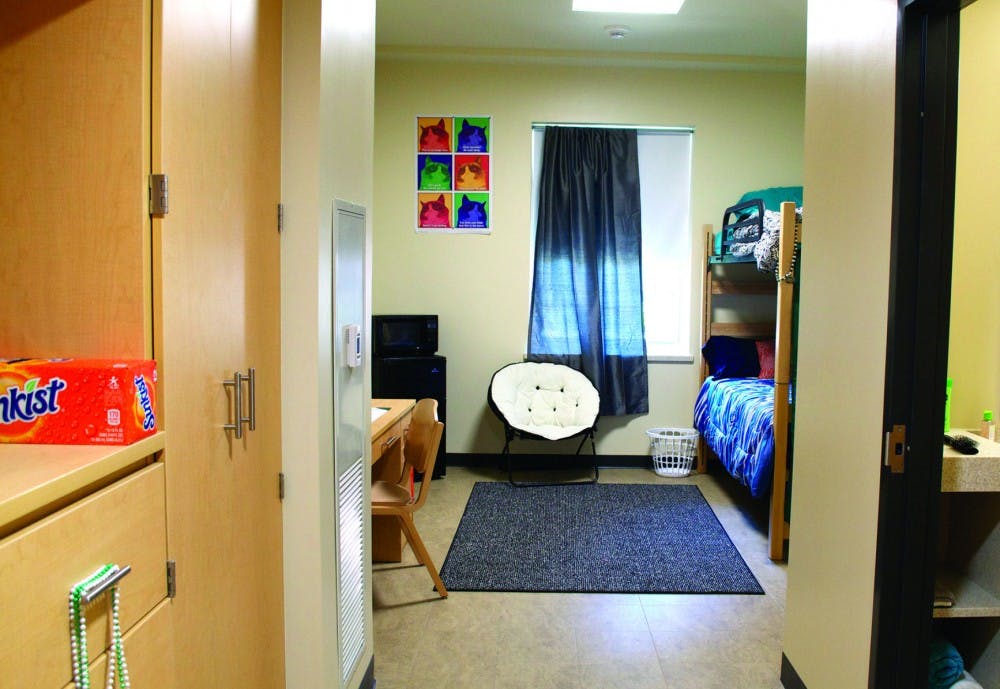Housing Master Plan update: Changes made to overall plan because of large freshman class, project still on schedule.
There are too many Ohio University students living on campus — thanks to the large incoming class this year. Now, officials won’t knock down all the residence halls they originally planned on demolishing in order to ensure those students have a place to sleep on campus.
The class of 2018, which most recently totaled 4,394 students, forced Residential Housing to house students on campus in non-traditional ways, including placing three students in a room initially set for two people and putting non-Residential Assistants with RAs.
Now, the influx of students has forced officials to delay demolishing some residence halls under its “Housing Master Plan.” The plan was originally designed to take 10 years to complete and includes demolishing 15, outdated residence halls on South Green and rebuilding new halls. Still, those new buildings won’t increase OU’s bed capacity.
There are four residence halls being constructed between Adams Hall and Clippinger Laboratories and will hold about 900 beds.
OU is now planning on demolishing fewer residence halls during the first phase of demolition, leaving more dorm rooms available to house students.
“We will still do some demolition, but not to the extent we originally planned,” said Christine Sheets, assistant vice president for capital and facilities planning.
Rather than demolishing about 900 beds worth of residence halls, OU will only demolish the Cady House, Foster House and Brough House complex, which has about 300 beds altogether.
The three buildings will be closed to students during the Fall Semester of the 2015-16 academic year, and the complex will likely be demolished during the spring of 2016, said Pete Trentacoste, executive director of Residential Housing.
Under the revised plan, OU should have 600 empty beds on campus next year — the difference between the residence halls being built and those being torn down — if OU sticks with its original goal of accepting fewer or no additional students to its Athens campus.
However, Sheets and Trentacoste did not say whether students will live in residence halls originally slated for demolition.
“I believe we’ll still do some demolitions,” she said. “Our numbers, as we plan out for next year, will drive (future demolition decisions).”
Before the record-breaking class stepped on campus, no demolition plans had been finalized, Sheets said.
Four residence halls currently being constructed are now about 40 percent complete, and are still on track to open in August 2015. Those buildings will house students during the 2015-16 academic year, Sheets said, despite a mistake made in the brick order over the summer.
About 100,000 bricks were delivered incorrectly, said Richard Shultz, director of design and construction, on a facilities conference call Thursday.
The bricks were supposed to come in three different colors: red, semi-dark and dark. Only 10 percent of the bricks were supposed to be dark; about 20 percent of those delivered were dark, Shultz said.
The dark bricks were placed in the building, and now a number need removed.
“The contractor has done an excellent job of cutting out and relaying the bricks,” Shultz said.
The brick mistake will not cost OU any extra money because the bricks are ordered and paid for by the construction company. Most of the utility work for the buildings was installed over the summer, when gas, water and electrical lines could be worked on without disrupting students, Sheets said.
A few feet away from the construction, OU has constructed a mock residence hall suite in the Adams Hall parking garage. The two bedrooms are full-scale replicas of what students can expect the new rooms to look like, including cabinets, furniture and a bathroom connecting the two rooms.
The new suites will have the same layout as the suites in Adams, but will have more square feet in each room. The new rooms will include new features, such as two USB ports and a dimmer switch for the overhead lights in the room.
“Because this is such a large project, we felt it was essential to (build these),” Sheets said.






